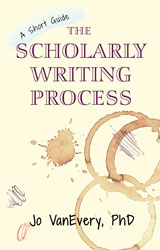
This is an excerpt from my book: The Scholarly Writing Process (A Short Guide). Designed to refer to whenever you get stuck, it breaks down the scholarly writing process into stages and provides both a description of that stage and writing prompts to help you get unstuck. Here’s the introduction and table of contents.
Introduction
Writing as Process & Product
The term “writing” is commonly used to describe both the act of articulating thoughts on paper (or it’s electronic equivalent) and the product of that process of articulation. This can create confusion in advice about writing. Are we talking about the product or the process? Which one should we be talking about?
Scientists have stopped debating whether light is a particle or a wave and accepted that it is both at the same time, even though you can only deal with it as a particle or a wave at any particular time. I suggest we do the same in our discussion of writing.
Writing is a process through which you create knowledge.
AND
Writing is a product that communicates knowledge.
To understand how to improve both process and product, we need to separate them heuristically. The process of communicating your work with others (which we call publication) goes on at the same time as the process of developing your ideas and arguments so that they are fit to be communicated with others. Neither the process nor the product is more important. Sometimes you focus on the process. Other times you focus on the product/publication. The shift in focus becomes a kind of dance.
Furthermore, because writing is so tied up with your identity, many of your struggles with writing are emotional. You have an emotional attachment to being competent, to being right, to being a good writer, to being part of a discipline/field/etc. You may also have an emotional connection to the topic you write about.
The emotional vulnerability of writing affects your writing process. Procrastination and distraction are often rooted in the desire to avoid writing that is emotionally difficult in some way. Perfectionism is often an attempt to protect yourself from painful criticism. It isn’t (just) the writing that is difficult but all the emotional processing that goes along with it that holds you back.
One of the members of the Academic Writing Studio reminded me that you don’t always need to know how to solve a problem to move forward. Being able to state the problem clearly often shifts things enough to allow movement. It doesn’t help to push your emotions away and pretend that the issue you face is merely a technical one that any good writer could overcome easily.
Each section is followed by writing prompts to help you figure out how the things discussed in that section apply to your particular situation. I expect you to dip into this as needed. So if you are having trouble getting started, you’d go straight to the Beginnings section, read, write a bit based on some of the prompts, and hopefully that gets you unstuck and writing!
Table of Contents:
- Preface: How to use this Short Guide
- Introduction: Writing as Process & Product
- Beginnings
- Moving Your Project Forward
- From process to product: Who are you writing for?
- Determining which writing products to prioritize
- Refining a specific writing product
- What is finished?
- Getting another perspective
- Submission, Revision, publication
- And you keep writing
- Notes & References
- Acknowledgements
- About the Author
Available now…
Interested? You can get The Scholarly Writing Process (A Short Guide) in various e-book formats now.
Don’t have an e-reader? A lot of the most popular platforms are also available as free apps for your phone, tablet, or computer.
Related Posts:
On research and emotional entanglement
Making Decisions about your writing
This post has been substantially re-edited in January 2024 to update formatting, links and add relevant and newer Related Posts.







